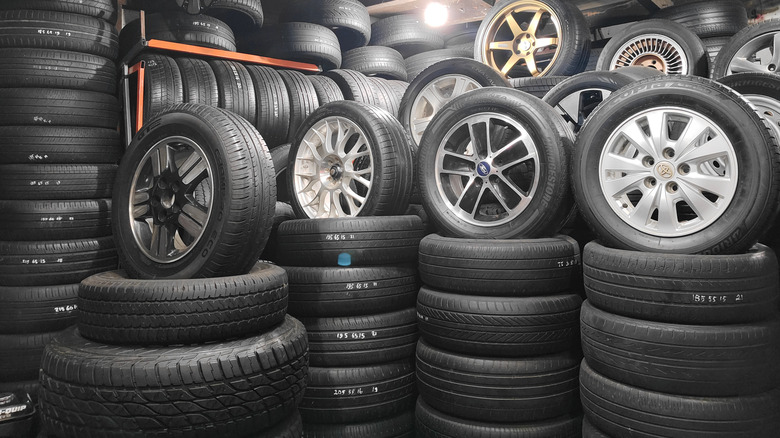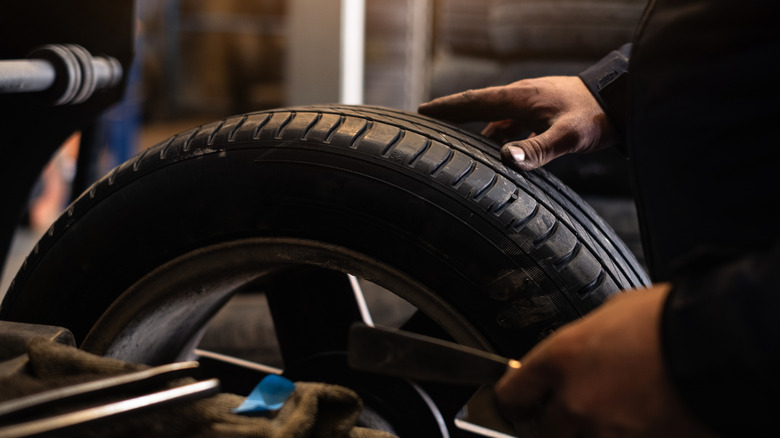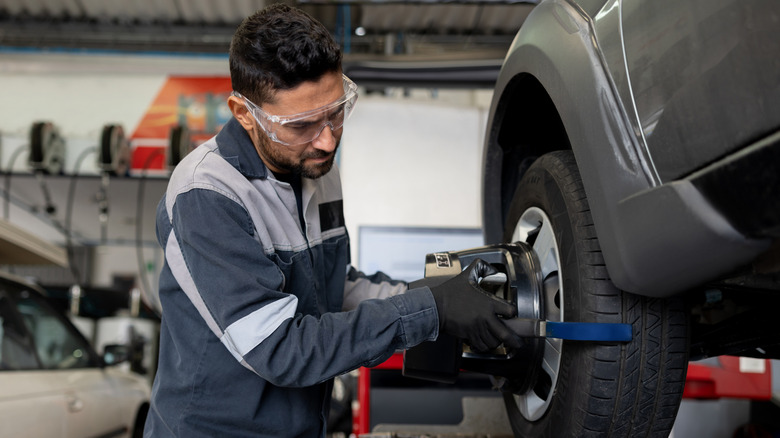Do Used Tires Need To Be Balanced? What To Know Before You Buy
The secret to making your vehicle last long is to prioritize regular maintenance. This can range from changing the air filters and engine oil, to installing new brake pads and spark plugs. However, while some maintenance projects might be too affordable for car owners, others can cost a pretty penny. In fact, tire replacement can set you back hundreds of dollars, with the average cost of new tires being pretty high. That's why most drivers usually go for the cheapest option on the shelf, which is used tires.
Of course, used tires can be an excellent way to save some cash, but it's a good idea to be careful, because sometimes looks can be deceiving, especially when it comes to tires. After all, unlike used cars that often come with a vehicle report, tires don't come with one. So, you'll never know their full history — how evenly they've worn over time, where they were stored, or how they were driven. This is where tire balancing comes in handy.
Now, when inspecting used tires, it's easy to assume that decent tread depths equal a problem-free tire. Actually, that's one of the most common mistakes drivers make when shopping for used tires. The truth is that, even if the surface of a tire appears fine, with plenty of tread left, uneven wear and minor deformities could be lurking.
These issues, plus prior damage, could throw off the tires' weight distribution. That imbalance might seem minor at a glance, but over time, it could result in premature tire wear and decreased fuel efficiency.
Why you need to balance used tires
If you're buying tires,new or used, balancing them is essential. After all, tire balancing will only cost $100 to $200, sometimes even free for new tires, and this will go a long way in making your tires last longer.
Now, one of the main reasons why used tires need balancing is to protect them from tread wear. If your tires are imbalanced, they will not spin evenly. This means that certain spots will wear out faster than others, and in turn, this will shorten your tire's lifespan, and also reduce its grip. At first, this might look like a minor issue, especially in dry conditions, but when you add a wet terrain into the mix, the likelihood of skidding and hydroplaning – something no driver wants to encounter — increases.
Apart from that, adding stress on your car's suspension system is another concern. If the tires vibrate, even slightly, the struts, shocks, and bearings will have to work extra hard to compensate. Also, the wobbling of the tires will affect the steering wheel, ultimately leading to a rough ride. Alongside that, the vibration can be a major hazard when driving, especially when you need your tires to be stable.
Other things to know before buying used tires
Buying used tires can be a smart purchase. After all, they can save you a chunk of change. However, while used tires can be safe to use, there are still many reasons why you may want to avoid buying cheap tires. It's always crucial that you know what you're getting into before committing to that secondhand set you want. Take your time, and check for issues that might affect your wallet, safety, and ride quality.
That said, start with a hands-on inspection and ensure that you carefully inspect every tread. If you notice that the car has uneven wear on tread patterns, that's a red flag — it may point to suspension or alignment problems, and you don't want your car to inherit these issues.
While at it, run your hands along the surface, with gloves if possible, and keep an eye for deep cuts, poorly repaired punctures, or dry rot cracks. Don't overlook the sidewalls — exposed cords can be proof enough that the tire's integrity has been compromised.
Lastly, inspect the tread depths. If the treads are less than 2/32", that is an accident waiting to happen. In fact, treads that are too shallow will not provide enough grip, won't channel water away, and will increase the risk of hydroplaning. To be safe, choose tires with a tread of at least 4/32", or better still, choose tires with 6/32" or more for adequate service.


